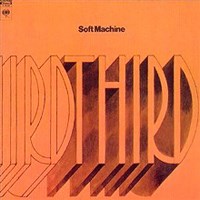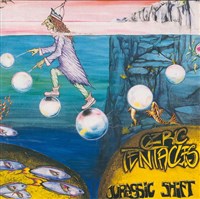
BY HASAN MURAT SÜMER (EE/IV)
hasan.sumer@ug.bilkent.edu.tr
So I’ve already discussed two examples from two different subdivisions (krautrock and raga rock) of psychedelic rock. Let’s go on:
Third – Soft Machine
This band named after the William Burroughs novel was, along with Caravan, the most notable band of the Canterbury scene. The designation “Canterbury scene” was  not originally based on musical style; it referred to a certain group of musicians and the bands they formed. The member lineups of these bands constantly changed and overlapped with each other, inevitably leading to some common elements in their music and thus creating the “Canterbury sound.” The common element of interest here is the psychedelic touch: it’s sometimes strong, sometimes weak, but it’s there.
not originally based on musical style; it referred to a certain group of musicians and the bands they formed. The member lineups of these bands constantly changed and overlapped with each other, inevitably leading to some common elements in their music and thus creating the “Canterbury sound.” The common element of interest here is the psychedelic touch: it’s sometimes strong, sometimes weak, but it’s there.
Soft Machine began its life with psychedelia-drenched poppy tunes and evolved into a key band of the jazz fusion genre, undergoing more than twenty lineup changes to date. The band at one point even included Allan Holdsworth (who influenced Van Halen, Satriani, Vai and many others) as guitarist.
Their third album, “Third” (1970), was recorded in a period of sharp transition, so I’ll label the genre of this four-lengthy-song double album “psychedelic jazz fusion.” The recording is fully instrumental except for the first half of the third track. Soft Machine certainly did not try to please the masses or the critics here. Five minutes into the album, and you would think that these are people who have just learned how to press the keys of a synthesizer having fun. Then the Canterbury sound, with hard drumming and frontal keyboards, begins, as the musicians start to improvise. This is where you realize that this is primarily a jazz fusion album. They jam for a while, with Canterbury’s joker card, the jazz flautist Jimmy Hastings (you see this man everywhere in the Canterbury scene), introduced into the flow, as is, subsequently, the saxophone; and then the first track ends. So, the style here is improvisation with distorted electronic sounds and loud drumming in the front, accompanied by instrumentally enriched or experimental passages.
Although the other three tracks deviate from this style in some ways, how much you like the first track will indicate how much you’ll like the whole album. The album’s title may refer not only to its sequence in the band’s releases but also to the third song on the recording, because it’s the band’s best-liked composition. In fact, there are significant numbers of people who claim on Internet forums that “Moon in June” is their favorite song. Robert Wyatt provides vocals in the first half, singing entertaining lyrics in a very sharp voice. An important musical figure, he also plays all of the instruments in the first half of the song. This first half of “Moon in June” is what earns the album the “progressive” label. After the vocals finish, the music returns to the style I described above. At the end of the song, the band performs some highly psychedelic and tasteful experimental passages with some especially captivating violin parts. “Third” is in fact pretty psychedelic overall, but I wouldn’t include it in the psychedelic rock category because its jazzy side is much more dominant. If you don’t like jazz, it’s not for you.
Jurassic Shift – Ozric Tentacles
 Soft Machine may be a listener’s measurement unit against which underground bands must be compared. However, Ozric Tentacles, who never left the underground, remain among the underground gods even today. Their style is difficult to categorize. I’m familiar with only a small part of their discography, and at least as far as this part is concerned, I can say that very powerful psychedelia is a core element of their music.
Soft Machine may be a listener’s measurement unit against which underground bands must be compared. However, Ozric Tentacles, who never left the underground, remain among the underground gods even today. Their style is difficult to categorize. I’m familiar with only a small part of their discography, and at least as far as this part is concerned, I can say that very powerful psychedelia is a core element of their music.
So, you’ve encountered a talented and knowledgeable group of musicians who reject every kind of fashion in music, and you’ve asked them to improvise something on the spot by mixing everything together. What they play for you is “Jurassic Shift” (1993). There is a good amount of influence from Eloy here. What they do is mix elements from trance, techno, fusion, krautrock, heavy metal and hard rock to make a mess. They then take this mess and filter it by passing it through space rock to smooth out the differences between the elements. Surprisingly, the resulting music is pretty accessible. Two weeks ago, I said that the album “Phallus Dei” was a journey with no destination. “Jurassic Shift” is the same, but the road is much less bumpy this time. I’m out.
